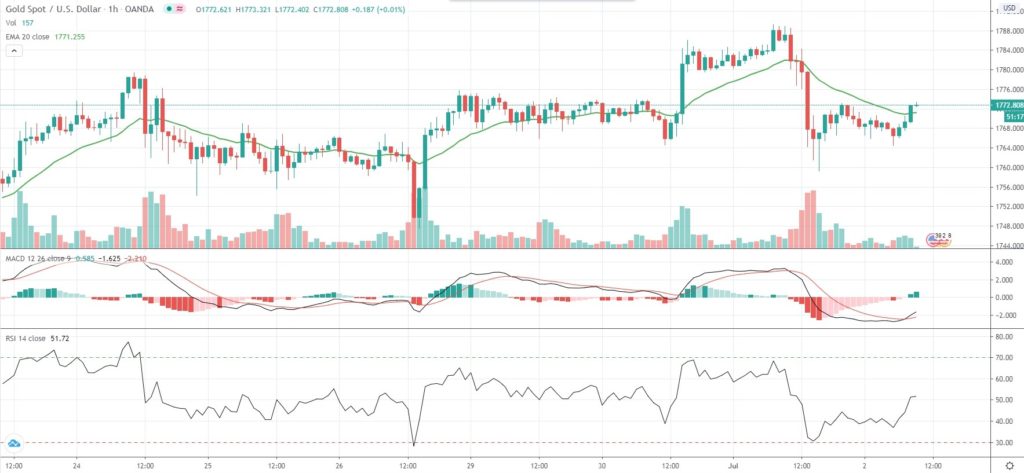Gold prices eased from Wednesday’s nearly 93-month high and remained within a narrow daily range on Thursday, as recent upbeat US macro data coupled with hopes for a potential coronavirus vaccine prompted investors to cut their safe haven bets.
Yesterday the Institute for Supply Management said US manufacturing activity had rebounded sharply in June, with the PMI pointing to the strongest expansion since April 2019, while a report by ADP showed US private sector companies had hired 2.369 million workers in June, following a revised up jobs gain of 3.065 million in May.
Business surveys from China and the Euro Area also indicated improving factory activity in June.
Risk sentiment received a boost also after news that a COVID-19 vaccine, co-developed by BioNTech and Pfizer, showed potential in early-stage human trials.
As of 9:20 GMT on Thursday Spot Gold was inching up 0.05% to trade at $1,771.42 per troy ounce, while moving within a daily range of $1,764.54-$1,773.50. On Wednesday the precious metal climbed as high as $1,789.27, or a price level not seen since October 5th 2012 ($1,796.00). Meanwhile, Gold futures for delivery in August were gaining 0.19% on the day to trade at $1,783.30 per troy ounce, while Silver futures for delivery in September were down 0.14% to trade at $18.192 per troy ounce.
The US Dollar Index, which reflects the relative strength of the greenback against a basket of six other major currencies, was edging down 0.18% on Thursday to 96.97, after earlier slipping as low as 96.95, or a level not seen since June 24th (96.55).
Today Gold traders will be paying attention to the key US Non-Farm Payrolls data, scheduled at 12:30 GMT. Employers in all segments of US economy, excluding the farming industry, probably added 3,000,000 new jobs in June, according to market expectations, after a job gain of 2,509,000 in May. Stronger-than-expected jobs growth may cool prospects of additional stimulus and push Gold prices lower.
A separate report by the Bureau of Economic Analysis at 12:30 GMT may show US trade deficit widened to $53 billion in May from $49.4 billion in April.
And the weekly report by the US Labor Department may show the number of initial jobless claims eased to 1,355,000 during the business week ended June 26th from 1,480,000 in the preceding week.
Meanwhile, near-term investor interest rate expectations were without change. According to CME’s FedWatch Tool, as of July 2nd, investors saw a 100.0% chance of the Federal Reserve keeping borrowing costs at the current 0%-0.25% level at its policy meeting on July 28th-29th, or unchanged compared to July 1st.
Daily Pivot Levels (traditional method of calculation)
Central Pivot – $1,773.01
R1 – $1,786.73
R2 – $1,802.99
R3 – $1,816.71
R4 – $1,830.44
S1 – $1,756.75
S2 – $1,743.03
S3 – $1,726.77
S4 – $1,710.52






